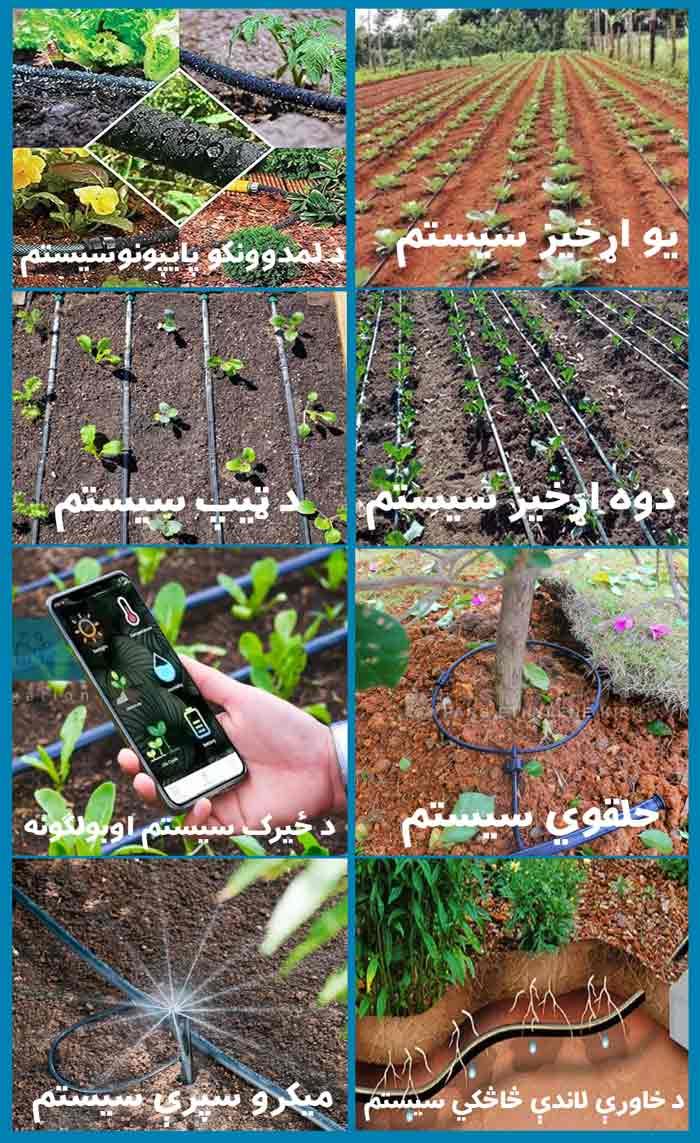
Drip Irrigation: An Efficient Way To Water Large Areas With Less Water
KABUL (Pajhwok): Experts and experienced farmers say the drip irrigation system should be promoted to irrigate large areas with minimal water, and they urge the government and aid agencies to raise public awareness in this regard and provide farmers with the necessary support.
The climatic conditions of land are rapidly changing; in some areas, with rising temperatures causing droughts. While in others they lead to severe storms, rainfall, and floods.
Afghanistan is one of the countries that emit very little (0.19%) greenhouse gases, yet reports show it ranks fourth among countries most affected by climate change. This situation has severely impacted the country's agricultural sector, which remains the main source of livelihood for nearly 80% of Afghans.
Irregular rainfall and floods associated with climate change have resulted in crop losses and reduced yields. Currently, drought has gripped many areas of Afghanistan.
Meanwhile, in Afghanistan, agricultural water is still largely applied using traditional methods, and very few people use drip irrigation systems.
What is a drip irrigation system?
Experts say that in this system, water reaches only the roots of trees and plants through pipes and drippers, allowing large fields to be irrigated efficiently with minimal water while producing better yields.
Types of drip irrigation systems
-
Low-pressure system: Suitable for small to medium-sized fields, operated manually or with small pumps.
High-pressure systems: Designed for large-scale or industrial farms, requiring powerful pumps.
Single-line system: A single pipe laid along crop rows with drippers supplying water to plants.
Double-line system: Two pipes placed on both sides of crop rows to supply water evenly to roots.
Ring system: Perforated pipes are laid in a circular shape around crop rows.
Subsurface drip irrigation: Pipes with drippers are buried 40 cm underground to reach roots directly.
Soaker hose system: Water slowly drips through small holes in the pipes; suitable for gardens.
Tape system: Uses plastic perforated tapes laid along rows to supply water to plants.
Smart irrigation system: Watering timing and control are managed via mobile devices.
Micro-spray system: Sprays water over crops from above.
Other systems may also exist.
According to Prof. Mustafa Abed of the Agronomy Department at Kabul University, while drip irrigation systems are diverse globally, in Afghanistan the most commonly used and effective system is the simple surface drip irrigation system.
Costs and benefits of drip irrigationAbed said the cost of a drip irrigation system depends on land size, elevation, depth, distance to water sources, and the farmer's knowledge of the system. On average, a surface system costs between 30,000 to 45,000 afghanis per jerib (approx. 0.2 hectares) in Afghanistan.
Currently, some farmers in Nangarhar, Herat, Nimroz, Zabul, Baghlan and Jawzjan provinces use this system, though the number is small. Some farmers have built the system at their own expense, while in other cases organizations have installed it for them.
Abed noted that in many areas of the country, farmers face drought, and in such conditions where water is scarce, this system is very beneficial. Traditional irrigation methods waste 40-60% of water, while drip irrigation prevents this wastage and also increases crop yields.
He emphasized that the Islamic Emirate of Afghanistan (IEA) and international agencies should work more in this sector by providing farmers with subsidies and necessary awareness so the system can become widespread in Afghanistan.
Farmers' opinions
In Kandahar, technical worker Naveed Bawar said farmers can save up to 75% of water with the drip irrigation system.
He highlighted its importance for pomegranate orchards, as pomegranate trees are sensitive to flooding and prone to certain diseases, which can reduce yields.
He added that the system not only saves water but also fertilizer, allows timely application and prevents pests and unwanted weed growth.
A farmer from the Dowlatzai area in Nangarhar, Wali Khan, told Pajhwok that no one in their area uses or is familiar with the drip irrigation system.
He added:“This land is dry, and the drip irrigation system gives good results. It retains moisture, whether for saplings or crops, and works very well. We want this system to be made available for us, and water storage facilities should be provided for it.”
Rohullah Rohani, a resident of Ghazni province, also said that most farmers in Ghazni do not know how to use the drip irrigation system, but he intends to implement it on his own land.
He stated that farmers should familiarize themselves with these new systems, and the government should provide public awareness along with financial and technical support.
Meanwhile, Ahmad Jan, a resident of Badamkhel in Narkh district of Maidan Wardak province, said that the water level in their area has dropped significantly, and he is now using the drip irrigation system with excellent results.
He explained that one of their villagers had worked in agriculture in Iran, and a few years ago, upon returning to Afghanistan, he installed a drip irrigation system for his land. Since then, several farmers in the area have also started using this system.
He added that with his two-inch water supply, he could normally irrigate five jeribs of land, but with drip irrigation, he can irrigate 10 to 16 jeribs.
He noted that many farmers are unfamiliar with the system and do not know whether their investment will be profitable or not, while the system actually increases land productivity.
Sifatullah, a farmer from Naway Kalai area, Daman district, Kandahar, said that for the past two years he has been using the drip irrigation system for his lands and is very satisfied.
He explained that he grows various crops on his eight jeribs of land, which could not even be fully irrigated by five people using traditional methods, but now he can manage irrigation alone through the drip system.
He added that the drip irrigation system has reduced his costs and increased his yields. He encouraged other farmers to also adopt this system.
Hatami: Working to promote the drip irrigation system
Mulavi Sher Mohammad Hatami, spokesman for the Ministry of Agriculture, Irrigation, and Livestock, said that drought caused by climate change has created challenges for farmers in some parts of the country. However, through drip irrigation, farmers can irrigate large areas with minimal water and achieve better yields.
Without going into details, he added that the ministry has many programs to manage water and address farmers' challenges, one of which is promoting the adoption of the drip irrigation system.
Hatami also emphasized that the ministry is making serious efforts to ensure that the drip irrigation system becomes widely adopted.
sa/ma

Legal Disclaimer:
MENAFN provides the
information “as is” without warranty of any kind. We do not accept
any responsibility or liability for the accuracy, content, images,
videos, licenses, completeness, legality, or reliability of the information
contained in this article. If you have any complaints or copyright
issues related to this article, kindly contact the provider above.

















Comments
No comment